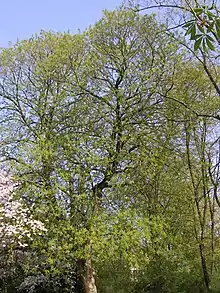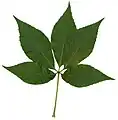Aesculus flava
Aesculus flava, also known commonly as the common buckeye, the sweet buckeye, and the yellow buckeye, is a species of deciduous tree in the subfamily Hippocastanoideae of the family Sapindaceae. The species is native to the Ohio Valley and Appalachian Mountains of the Eastern United States.[2] It grows in mesophytic forest or floodplains, generally in acid to circumneutral soil, reaching a height of 20m to 48m (65 ft to 154 ft).
| Aesculus flava | |
|---|---|
 | |
| Scientific classification | |
| Kingdom: | Plantae |
| Clade: | Tracheophytes |
| Clade: | Angiosperms |
| Clade: | Eudicots |
| Clade: | Rosids |
| Order: | Sapindales |
| Family: | Sapindaceae |
| Genus: | Aesculus |
| Species: | A. flava |
| Binomial name | |
| Aesculus flava | |
 | |
| Synonyms | |
|
Aesculus octandra Marshall | |
Description
The leaves are palmately compound with five (rarely seven) leaflets, 10–25 cm (3.9–9.8 in) long and broad. The flowers are produced in panicles in spring, yellow to yellow-green, each flower 2–3 cm (0.79–1.18 in) long with the stamens shorter than the petals (unlike the related A. glabra, Ohio buckeye, in which the stamens are longer than the petals). The twigs have a faintly rank odor, but much less so than the Ohio buckeye, A. glabra. The fruit is a smooth (spineless), round or oblong capsule 5–7 cm (2.0–2.8 in) in diameter, containing 1-3 nut-like seeds, 2.5–3.5 cm (0.98–1.38 in) in diameter, brown with a whitish basal scar. The fruit is poisonous to humans but can be made edible through a leaching process.
Cultivation
Aesculus flava is cultivated as an ornamental tree. The tree's showy yellow flowers and good autumn color are attractive in larger gardens and in parks.[3]
This plant has gained the Royal Horticultural Society's Award of Garden Merit.[4]
It has been marked as a pollinator plant that attracts hummingbirds and bees.[5]
Uses
Native Americans roasted and soaked the poisonous seeds to remove the toxic element and consume them as food.[6]
Photo gallery
 Leaf
Leaf Bark
Bark Spring bud break
Spring bud break Fruit
Fruit
References
- Stritch, L. (2018). "Aesculus flava". IUCN Red List of Threatened Species. 2018: e.T60757580A60757583. doi:10.2305/IUCN.UK.2018-1.RLTS.T60757580A60757583.en. Retrieved 12 November 2021.
- "Aesculus octandra Range Map" (PDF). United States Geological Survey. Archived from the original (PDF) on 2008-05-09. Retrieved 2008-03-06.
- Missouri Botanical Garden horticultural treatment: Aesculus flava . accessed 1.31.2013
- "RHS Plant Selector - Aesculus flava". Retrieved 23 February 2020.
- "Planting Guides" (PDF). Pollinator.org. Retrieved 2022-01-29.
- Little, Elbert L. (1980). The Audubon Society Field Guide to North American Trees: Eastern Region. New York: Knopf. p. 586. ISBN 0-394-50760-6.
External links
- Yellow Buckeye Archived 2015-12-02 at the Wayback Machine Diagnostic images, Morton Arboretum acc. 12-U*1
- Bioimages.vanderbilt.edu — Aesculus flava photo gallery
- Ohio Buckeye Trivia Cards tell about the buckeye, buckeye tree, buckeye history, buckeye folklore and more.
